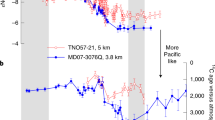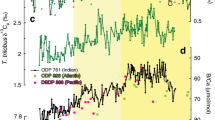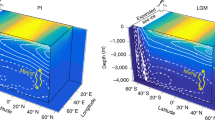Abstract
Geologic intervals of sustained warmth such as the mid-Pliocene Warm Period can inform our understanding of future climate change, including the long-term consequences of oceanic uptake of anthropogenic carbon. Here we generate carbon isotope records and synthesize existing records to reconstruct the position of water masses and determine circulation patterns in the deep Pacific Ocean. We show that the mid-depth carbon isotope gradient in the North Pacific was reversed during the mid-Pliocene compared with today, which implies water flowed from north to south and deep water probably formed in the subarctic North Pacific Deep Water. An isotopically enabled climate model that simulates this North Pacific Deep Water reproduces a similar carbon isotope pattern. Modelled levels of dissolved inorganic carbon content in the North Pacific decrease slightly, although the amount of carbon stored in the ocean actually increases by 1.6% relative to modern due to an increase in dissolved inorganic carbon in the surface ocean. Although the modelled Pliocene ocean maintains a carbon budget similar to the present, the change in deep ocean circulation configuration causes pronounced downstream changes in biogeochemistry.
This is a preview of subscription content, access via your institution
Access options
Access Nature and 54 other Nature Portfolio journals
Get Nature+, our best-value online-access subscription
$29.99 / 30 days
cancel any time
Subscribe to this journal
Receive 12 print issues and online access
$259.00 per year
only $21.58 per issue
Buy this article
- Purchase on Springer Link
- Instant access to full article PDF
Prices may be subject to local taxes which are calculated during checkout



Similar content being viewed by others
Data availability
The stable isotope data generated here for Shatsky Rise and those compiled for the spatial analyses are available at figshare (DOI: 10.6084/m9.figshare.20233857) and will also be available on Pangaea.de.
Code availability
The CESM 1.2.2.1 code used to run the climate simulations is available from https://svn-ccsm-models.cgd.ucar.edu/cesm1/release_tags/cesm1_2_2_1. The code modifications made to CESM 1.2.2.1 to include carbon isotopes following ref. 38 are available from https://github.com/nburls/FordEtAl2022_CISOmods. Figures with coastal outlines (for example, Figs. 1 and 2 and Extended Data Figs. 1 and 2) were created in Matlab with the M_maps package71.
References
Pachauri, R. K., M. R. Allen, V. R. Barros, and J. Broome (2014), Climate Change 2014: Synthesis Report. Contribution of Working Groups I, II and III to the Fifth Assessment Report of the Intergovernmental Panel on Climate Change,
Rahmstorf, S. Ocean circulation and climate during the past 120,000 years. Nature 419, 207–214 (2002).
Warren, B. A. Why is no deep water formed in the North Pacific? J. Mar. Res. 41, 327–347 (1983).
Burls, N. J. et al. Active Pacific meridional overturning circulation (PMOC) during the warm Pliocene. Sci. Adv. 3, e1700156 (2017).
Kwiek, P. & Ravelo, A. C. Pacific Ocean intermediate and deep water circulation during the Pliocene. Palaeogeogr. Palaeoclimatol. Palaeoecol. 154, 191–217 (1999).
McKinley, C. C., Thomas, D. J., LeVay, L. J. & Rolewicz, Z. Nd isotopic structure of the Pacific Ocean 40–10 Ma, and evidence for the reorganization of deep North Pacific Ocean circulation between 36 and 25 Ma. Earth Planet. Sci. Lett. 521, 139–149 (2019).
Rae, J. W. et al. Deep water formation in the North Pacific and deglacial CO2 rise. Paleoceanography 29, 645–667 (2014).
Thomas, D. J. Evidence for deep-water production in the North Pacific Ocean during the early Cenozoic warm interval. Nature 430, 65–68 (2004).
Haywood, A. M. et al. A return to large-scale features of Pliocene climate: the Pliocene Model Intercomparison Project phase 2. Preprint at Copernicus https://doi.org/10.5194/cp-2019-145 (2020).
de la Vega, E. et al. Atmospheric CO2 during the mid-Piacenzian Warm Period and the M2 glaciation. Sci. Rep. 10, 11002 (2020).
McClymont, E. L. et al. Lessons from a high-CO2 world: an ocean view from ~3 million years ago. Clim. Past 16, 1599–1615 (2020).
Brierley, C., Burls, N., Ravelo, C. & Fedorov, A. Pliocene warmth and gradients. Nat. Geosci. 8, 419–420 (2015).
Burls, N. J. & Fedorov, A. V. What controls the mean east–west sea surface temperature gradient in the equatorial Pacific: the role of cloud albedo. J. Clim. 27, 2757–2778 (2014).
Fedorov, A. V., Burls, N.J., Lawrence, K. T. and Peterson, L. C. Tightly linked zonal and meridional sea surface temperature gradients over the past five million years. Nat. Geosci. https://doi.org/10.1038/ngeo2577 (2015).
Burls, N. J. & Fedorov, A. V. Wetter subtropics in a warmer world: contrasting past and future hydrological cycles. Proc. Natl Acad. Sci. USA 28, 12888–12893 (2017).
Lyle, M. & Baldauf, J. Biogenic sediment regimes in the Neogene equatorial Pacific, IODP Site U1338: burial, production, and diatom community. Palaeogeogr. Palaeoclimatol. Palaeocol. 433, 106–128 (2015).
Shankle, M. G. et al. Pliocene decoupling of equatorial Pacific temperature and pH gradients. Nature 598, 457–461 (2021).
Curry, W. B. & Oppo, D. W. Glacial water mass geometry and the distribution of δ13C of ΣCO2 in the western Atlantic Ocean. Paleoceanogr. Paleoclimatol. https://doi.org/10.1029/2004PA001021 (2005).
Kroopnick, P. M. The distribution of 13C of ΣCO2 in the world oceans. Deep Sea Res. A 32, 57–84 (1985).
Schmittner, A. et al. Calibration of the carbon isotope composition (δ13C) of benthic foraminifera. Paleoceanogr. Paleoclimatol. 32, 512–530 (2017).
Gu, S. et al. Assessing the potential capability of reconstructing glacial Atlantic water masses and AMOC using multiple proxies in CESM. Earth Planet. Sci. Lett. 541, 116294 (2020).
Lozier, M. S. Deconstructing the conveyor belt. Science 328, 1507–1511 (2010).
Jian, Z. et al. Pliocene–Pleistocene stable isotope and paleoceanographic changes in the northern South China Sea. Palaeogeogr. Palaeoclimatol. 193, 425–442 (2003).
Mix, A. et al. Benthic foraminifer stable isotope recond from Site 849 (0–5 Ma): local and global climate changes. In Proc. Ocean Drilling Program, Scientific Results 138 (eds Pisias, N. G. et al.), 371–412 (1995).
Tian, J., Wang, P., Cheng, X. & Li, Q. Astronomically tuned Plio–Pleistocene benthic δ18O record from South China Sea and Atlantic–Pacific comparison. Earth Planet. Sci. Lett. 203, 1015–1029 (2002).
Whitman, J. M. & Berger, W. H. Pliocene–Pleistocene carbon isotope record, Site 586, Ontong Java Plateau. Mar. Micropaleontol. 130, 333–348 (1993).
Caballero-Gill, R. P., Herbert, T. D. & Dowsett, H. J. 100‐kyr paced climate change in the Pliocene Warm Period, Southwest Pacific. Paleoceanogr. Paleoclimatol. 34, 524–545 (2019).
Karas, C. et al. Mid-Pliocene climate change amplified by a switch in Indonesian subsurface throughflow. Nat. Geosci. 2, 434–438 (2009).
McClymont, E. L. et al. Pliocene‐Pleistocene evolution of sea surface and intermediate water temperatures from the southwest Pacific. Paleoceanography 31, 895–913 (2016).
Tiedemann, R., Sturm, A., Steph, S., Lund, S. P. & Stoner, A. J. S. Astronomically calibrated timescales from 6 to 2.5 Ma and benthic isotope stratigraphies, Sites 1236, 1237, 1239, and 1241. In Proc. Ocean Drilling Program, Scientific Results 202 (eds Tiedman, R. et al.), 1–69 (2007).
Venti, N. L. & Billups, K. Stable-isotope stratigraphy of the Pliocene–Pleistocene climate transition in the northwestern subtropical Pacific. Palaeogeogr. Palaeoclimatol. 326-328, 54–65 (2012).
Shackleton, N. J., Hall, M. A. & Pate, D. Pliocene stable isotope stratigraphy of Site 846. In Proc. Ocean Drilling Program, Scientific Results 138 (eds Pisias, N. G. et al.), 337–355 (1995).
Abell, J. T., Winckler, G., Anderson, R. F. & Herbert, T. D. Poleward and weakened westerlies during Pliocene warmth. Nature 589, 70–75 (2021).
Lam R. A. et al. Pliocene to Earliest Pleistocene (5–2.5 Ma) Reconstruction of the Kuroshio Current Extension Reveals a Dynamic Current. https://doi.org/10.1029/2021PA004318 (2021).
Venti, N. L., Billups, K. & Herbert, T. D. Paleoproductivity in the northwestern Pacific Ocean during the Pliocene-Pleistocene climate transition (3.0–1.8 Ma) https://doi.org/10.1002/2016PA002955 (2017).
Haywood, A. M. et al. Large-scale features of Pliocene climate: results from the Pliocene Model Intercomparison Project. Climate 9, 191–209 (2013).
Moore, J. K., Doney, S. C. & Lindsay, K. Upper ocean ecosystem dynamics and iron cycling in a global three-dimensional model. Global Biogeochem. Cycles https://doi.org/10.1029/2004GB002220 (2004).
Jahn, A. et al. Carbon isotopes in the ocean model of the Community Earth System Model (CESM1). Geosci. Model Dev. 8, 2419–2434 (2015).
Gruber, N., Sabine, C. L., Feely, R. A., Key, R. M. & Lee, K. The oceanic sink for anthropogenic CO2 from 1994 to 2007. Science 363, 1193–1199 (2019).
Lawrence, K. T. et al. Time-transgressive North Atlantic productivity changes upon Northern Hemisphere glaciation. Paleoceanogr. Paleoclimatol. 28, 740–751 (2013).
Haug, G., Sigman, D., Tiedemann, R., Pedersen, T. & Sarnthein, M. Onset of permanent stratification in the subarctic Pacific Ocean. Nature 401, 779–782 (1999).
Woodard, S. C. et al. Antarctic role in Northern Hemisphere glaciation. Science 346, 847–851 (2014).
Patterson, M. O. et al. A Southwest Pacific perspective on long-term global trends in Pliocene–Pleistocene stable isotope records. Paleoceanogr. Paleoclimatol. 33, 825–839 (2018).
Woodhouse, A. et al. Adaptive ecological niche migration does not negate extinction susceptibility. Sci. Rep. 11, 15411 (2021).
Ahn, S., Khider, D., Lisiecki, L. E. & Lawrence, C. E. A probabilistic Pliocene–Pleistocene stack of benthic δ18O using a profile hidden Markov model. Dyn. Stat. Clim. Syst. 2, 91–16 (2017).
Butcher, S., King, T. & Zalewski, L. Apocrita—High Performance Computing Cluster for Queen Mary University of London (2017).
Lin, L., Khider, D., Lisiecki, L. E. & Lawrence, C. E. Probabilistic sequence alignment of stratigraphic records. Paleoceanogr. Paleoclimatol. 29, 976–989 (2014).
Lisiecki, L. E. & Raymo, M. E. A Pliocene–Pleistocene stack of 57 globally distributed benthic δ18O records. Paleoceanogr. Paleoclimatol. 20, PA1003 (2005).
Duplessy, J. C. et al. 13C record of benthic foraminifera in the last interglacial ocean: implications for the carbon cycle and the global deep water circulation. Quat. Res. https://doi.org/10.1016/0033-5894(84)90099-1 (1984).
Shields, C. A. et al. The low-resolution CCSM4. J. Clim. 25, 3993–4014 (2012).
Burls, N. J. & Fedorov, A. V. Simulating Pliocene warmth and a permanent El Niño‐like state: the role of cloud albedo. Paleoceanogr. Paleoclimatol. 29, 893–910 (2014).
Brierley, C. M. & Fedorov, A. V. Comparing the impacts of Miocene–Pliocene changes in inter-ocean gateways on climate: Central American Seaway, Bering Strait, and Indonesia. Earth Planet. Sci. Lett. 444, 116–130 (2016).
bin Shaari, H., Yamamoto, M. & Irino, T. Enhanced upwelling in the eastern equatorial Pacific at the last five glacial terminations. Paleogeogr. Paleoclimatol. 386, 8–15 (2013).
Brierley, C. M. et al. Greatly expanded tropical warm pool and weakened Hadley circulation in the early Pliocene. Science 323, 1714–1718 (2009).
Dekens, P. S., Ravelo, A. C. & McCarthy, M. D. Warm upwelling regions in the Pliocene Warm Period. Paleoceanogr. Paleoclimatol. 22, PA3211 (2007).
Etourneau, J., Schneider, R., Blanz, T. & Martinez, P. Intensification of the Walker and Hadley atmospheric circulations during the Pliocene–Pleistocene climate transition. Earth Planet. Sci. Lett. 297, 103–110 (2010).
Herbert, T. D. et al. Late Miocene global cooling and the rise of modern ecosystems. Nat. Geosci. https://doi.org/10.1038/ngeo2813 (2016).
LaRiviere, J. P. et al. Late Miocene decoupling of oceanic warmth and atmospheric carbon dioxide forcing. Nature 486, 97–100 (2012).
Lawrence, K. T., Liu, Z. & Herbert, T. D. Evolution of the eastern tropical Pacific through Plio-Pleistocene glaciation. Science 312, 79–83 (2006).
Li, L. et al. A 4-Ma record of thermal evolution in the tropical western Pacific and its implications on climate change. Earth Planet. Sci. Lett. 309, 10–20 (2011).
Liu, J. et al. Eastern equatorial Pacific cold tongue evolution since the late Miocene linked to extratropical climate. Sci. Adv. 5, eaau6060 (2019).
Martinez-Garcia, A., Rosell-Mele, A., McClymont, E. L., Gersonde, R. & Haug, G. H. Subpolar link to the emergence of the modern equatorial Pacific cold tongue. Science 328, 1550–1553 (2010).
O’Brien, C. L. et al. High sea surface temperatures in tropical warm pools during the Pliocene. Nat. Geosci. https://doi.org/10.1038/ngeo2194 (2014).
Pagani, M., Liu, Z., LaRiviere, J. & Ravelo, A. C. High Earth-system climate sensitivity determined from Pliocene carbon dioxide concentrations. Nat. Geosci. 3, 27–30 (2010).
Rousselle, G., Beltran, C., Sicre, M.-A., Raffi, I. & De Rafélis, M. Changes in sea-surface conditions in the equatorial Pacific during the middle Miocene–Pliocene as inferred from coccolith geochemistry. Earth Planet. Sci. Lett. 361, 412–421 (2013).
Seki, O. et al. Paleoceanographic changes in the eastern equatorial Pacific over the last 10 Myr. Paleoceanogr. Paleoclimatol. https://doi.org/10.1029/2011PA002158 (2012).
Zhang, Y. G., Pagani, M. & Liu, Z. A 12-million-year temperature history of the tropical Pacific Ocean. Science 344, 84–87 (2014).
Tierney, J. E. & Tingley, M. P. BAYSPLINE: a new calibration for the alkenone paleothermometer. Paleoceanogr. Paleoclimatol. 33, 281–301 (2018).
Müller, P. J., Kirst, G., Ruhland, G., von Storch, I. & Rosell-Mele, A. Calibration of the alkenone paleotemperature index U37K′ based on core-tops from the eastern South Atlantic and the global ocean (60° N–60° S). Geochim. Cosmochim. Acta 62, 1757–1772 (1998).
Tierney, J. E., Haywood, A. M., Feng, R., Bhattacharya, T. & Otto-Bliesner, B. L. Pliocene warmth consistent with greenhouse gas forcing. Geophys. Res. Lett. 46, 9136–9144 (2019).
Pawlowicz, R. M_Map: A mapping package for MATLAB v.1.4m (2020); www.eoas.ubc.ca/~rich/map.html
Acknowledgements
We thank J. Booth, J. Rolfe and J. Nicolson for their laboratory assistance and the International Ocean Discovery Program core repository for providing samples. This work benefited from conversations with L. Haynes and M. Lyle. We acknowledge high-performance computing support from Cheyenne (https://doi.org/10.5065/D6RX99HX) provided by NCAR’s Computational and Information Systems Laboratory, sponsored by the NSF. This work was supported by Natural Environment Research Council (NE/N015045/1; H.L.F.), the National Science Foundation (OCE-1844380 and OCE-2002448; N.J.B.) and a Sloan Ocean Fellowship (N.J.B.). H.L.F. personally thanks the breast cancer oncology, chemotherapy, radiotherapy and surgical team at St Bartholomew’s Hospital.
Author information
Authors and Affiliations
Contributions
H.L.F. and N.J.B. designed, analysed and interpreted the data. P.J. contributed to the numerical simulations and carbon budget analyses. H.L.F. wrote the manuscript with contributions from N.J.B.; H.L.F., N.J.B., P.J., A.J., R.P.C.-G., D.A.H. and A.V.F. contributed to the manuscript and the revisions.
Corresponding author
Ethics declarations
Competing interests
The authors declare no competing interests.
Peer review
Peer review information
Nature Geoscience thanks Claire McKinley and the other, anonymous, reviewer(s) for their contribution to the peer review of this work. Primary Handling Editor: James Super, in collaboration with the Nature Geoscience team.
Additional information
Publisher’s note Springer Nature remains neutral with regard to jurisdictional claims in published maps and institutional affiliations.
Extended data
Extended Data Fig. 1 Global benthic foraminifera oxygen isotope stack and North Pacific records.
Benthic isotope records of Prob-stack (A45), Site 1209 δ18O (B, blue circles) and δ13C (C, blue squares), and Site 1210 δ18O (D, orange circles) and δ13C (E, orange squares). The grey shading indicates the mid-Piacenzian warm period. Northern Hemisphere Glaciation (NHG) and Marine Isotope Stages KM3 and M2 are labelled.
Extended Data Fig. 2 Pliocene sea surface temperature records.
Sea surface temperature (SST) anomaly maps for the mid-Pliocene Warm Period (mid-Piacenzian 3.264–3.025 Ma) and Early Pliocene (4–5 Ma).
Extended Data Fig. 3 Early Pliocene δ13C anomaly maps for the Pacific Ocean.
Observed benthic δ13C and modelled zonal-mean (shaded contours in ‰) anomalies for the Early Pliocene (4–5 Ma). The benthic δ13C anomaly (‰) is calculated from the OC3 database20 with Late Holocene core top (diamonds) and modern δ13C ocean water (squares) values. Large symbols for open ocean sites are outlined in black, while symbols for marginal sites possibly influenced by boundary effects are small and outlined in grey. Horizontal basin-wide δ13C anomalies for 1000–1500 m (A), 2200–2800 m (B), and 3200–4000 m (C) water depth. The largest anomaly is found in the west due to western intensification of deep ocean circulation. The vertical cross section across the Pacific (D) shows the core and spatial extent of the PMOC.
Extended Data Fig. 4 Meridional overturning circulation in the Indo-Pacific Ocean.
Meridional overturning stream function in the Indo-Pacific ocean (in Sverdup, Sv) for the Pre-industrial (A), mid-Pliocene-like (mid-Piacenzian) (B), and Early Pliocene (C) model simulations. Contour interval is 2 Sv. Note the absence of active overturning cells in the preindustrial simulation other than the upper-ocean wind-driven cells.
Extended Data Fig. 5 Meridional ideal age for in Indo-Pacific Ocean.
Meridional ideal age in the Indo-Pacific ocean for the mid-Pliocene-like (mid-Piacenzian) (A), and Early Pliocene (B) model simulations minus Pre-industrial. Contour interval is 100 ideal years.
Extended Data Fig. 6 Modelled DIC anomaly for the Pacific Ocean basin.
Pacific basin modelled DIC anomaly from the Pre-Industrial to the mid-Pliocene-like simulation.
Extended Data Fig. 7 Modelled zonal mean DIC anomaly for the Pacific Ocean.
Pacific basin modelled zonal mean DIC anomaly from the Pre-Industrial to the mid-Pliocene-like simulation.
Extended Data Fig. 8 Model run age and DIC anomaly.
Time series of modelled DIC anomaly from the Pre-Industrial to the mid-Pliocene-like simulation. Deep ocean is near equilibrium at ~2000 model run years.
Supplementary information
Supplementary Data 1
Site information including site name, longitude, latitude and bottom water depth (m). OC3 data including pre-industrial δ13C natural ocean water column bottle data and Late Holocene δ13C from the benthic foraminifera genus Cibicides with the relevant search parameters for each site. Early Pliocene (4–5 Ma) δ13C values, standard deviation and number of data points within the interval. Calculated anomaly (Early Pliocene minus pre-industrial/Late Holocene). References used in the compilation
Rights and permissions
About this article
Cite this article
Ford, H.L., Burls, N.J., Jacobs, P. et al. Sustained mid-Pliocene warmth led to deep water formation in the North Pacific. Nat. Geosci. 15, 658–663 (2022). https://doi.org/10.1038/s41561-022-00978-3
Received:
Accepted:
Published:
Issue Date:
DOI: https://doi.org/10.1038/s41561-022-00978-3
This article is cited by
-
Intermediate water circulation drives distribution of Pliocene Oxygen Minimum Zones
Nature Communications (2023)



